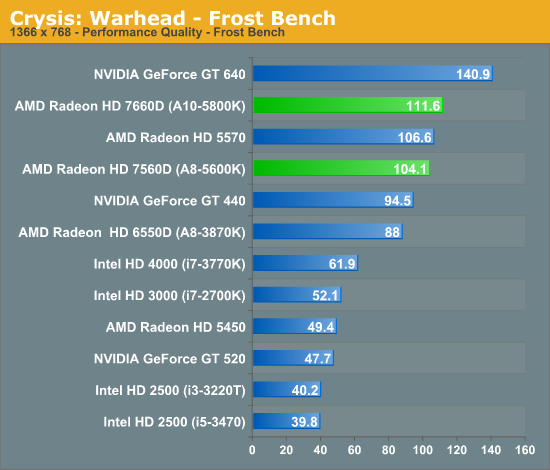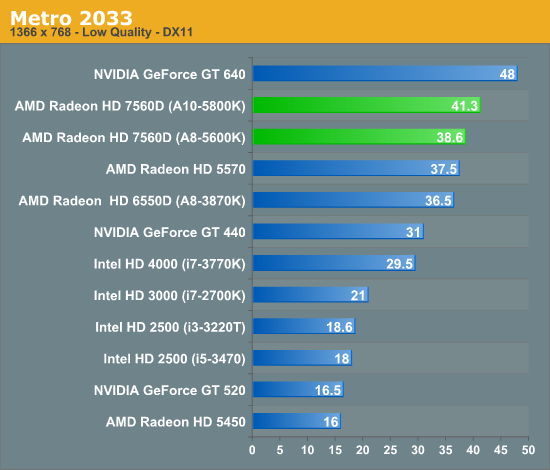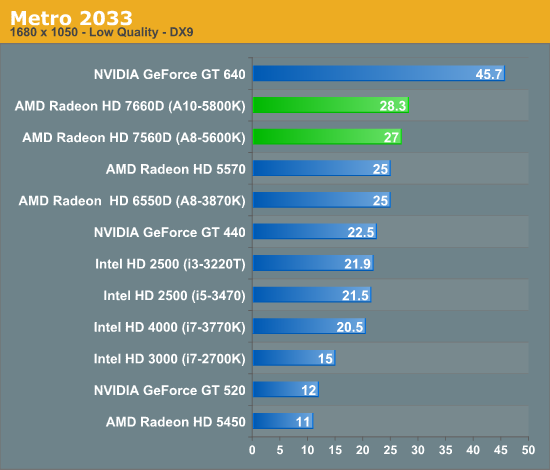AMD A10-5800K & A8-5600K Review: Trinity on the Desktop, Part 1
by Anand Lal Shimpi on September 27, 2012 12:00 AM ESTCrysis: Warhead
Our first graphics test is Crysis: Warhead, which in spite of its relatively high system requirements is the oldest game in our test suite. Crysis was the first game to really make use of DX10, and set a very high bar for modern games that still hasn't been completely cleared. And while its age means it's not heavily played these days, it's a great reference for how far GPU performance has come since 2008. For an iGPU to even run Crysis at a playable framerate is a significant accomplishment, and even more so if it can do so at better than performance (low) quality settings.



Crysis sets the tone for a lot of what we'll see in this performance review. The Radeon HD 7660D on AMD's A10-5800K boosts performance by around 15 - 26% over the top end Llano part. The smaller, Radeon HD 7560D GPU manages a small increase over the top-end Llano at worst, and at best pulls ahead by 18%.
Compared to Ivy Bridge, well, there's no comparison. Trinity is significantly faster than Intel's HD 4000, and compared to HD 2500 the advantage is tremendous.
Metro 2033
Our next graphics test is Metro 2033, another graphically challenging game. Like Crysis this is a game that is traditionally unplayable on many integrated GPUs, even in DX9 mode.



Metro 2033 shows us a 6 - 13% performance advantage for the top end Trinity part compared to Llano. The advantage over Intel's HD 4000 ranges from 20 - 40% depending on the resolution/quality settings. In general AMD is able to either deliver the same performance at much better quality or better performance at the same quality as Ivy Bridge.
The more important comparison is looking at the A8-5600K vs. Intel's HD 4000 and 2500. AMD is still able to hold onto a significant advantage there, even with its core-reduced GPU.










139 Comments
View All Comments
parkerm35 - Monday, October 1, 2012 - link
First of all you have never owned a 3870k, as your just an Intel fan boy wanting some attention. The simple fact is you have chosen to look for an AMD review to feed us this rubbish, this just shows how obssesed you are. If you don't like AMD parts, that's fine, but it's because of people like you why AMD is in this kind of mess to start of with. I bet your one of these people who went out and bought a P4 as well?This review has just shown you this APU competing with discrete graphics cards, and doing a damn good job at it too. How much was your G620? add the price of a discrete card that is capable of matching the trinity, maybe looking at a GT630 (which i think will be slightly slower), $70? + $65 for the CPU $135 for a dual core, slower CPU and in all a more power hungry setup. Do me a favor.
" A G620 can compete generally with a 3870K on the CPU side. That is just embarrassing. The 5800K isn't much of an improvement."
How do you know the 5800k isn't much of an improvement? This hole review is about GPUs, no CPU data what so ever.
Could you please list these HD1000 parts with quicksync.
kpo6969 - Thursday, September 27, 2012 - link
Anand if you went along with this your stock as one of (if not the best) reviews to trust site has gone way down. Just my opinion.rhx123 - Thursday, September 27, 2012 - link
I agree. They should have done the same as TechReport and called AMD out on this.I have been a long time lurker, and I nearly posted about Anandtech's spin on the Enduro Update, but now it really feels like there's something going on between the two.
It's obvious that in making AMD hold this information back, it's confirmed to everyone in the know that piledriver is going to be rubbish , and has probably done AMD more damage than just letting people release the benchmarks.
Just hoping a Chinese reviewer somewhere can get his hands on the parts and release some real CPU benchmarks.
jaydee - Thursday, September 27, 2012 - link
Fortuanately, Anand has more class than to be a blatant hypocrite like "Tech Report" in happily preview Intels chips under certain parameters, but complaining about it when AMD does it.http://techreport.com/review/9538/intel-conroe-per...
cobalt42 - Thursday, September 27, 2012 - link
You're simply pointing out the difference between a PRE-view and a RE-view, not pointing out any supposed hypocrisy.A preview is often done on the manufacturer's terms. Compare to what is often done in gaming; you get to see what they show you, and you're careful not to draw conclusions. (To quote TR's conclusions in that article you cite, they start with "Clearly, it's way too early to call this race.") Previews are also often done when you're offsite and in their controlled conditions. Plus, the article you write about it is called a "preview" in the title, not a "review". Look at the title of these articles versus the one you cite.
What AMD is trying to do here is control the output of REviews.
Visual - Thursday, September 27, 2012 - link
The high-end GPU version seems nice, its disappointing there are weaker versions though. Especially the mobile version, with not nearly enough performance to distinguish itself from the intel offering.Jamahl - Thursday, September 27, 2012 - link
Can you point out that the GT 640 in this review is in an Ivy bridge powered system? It would have been nice to have it running in the 5800K system, just to see how close the graphics portion of Trinity really is to it.Rick83 - Thursday, September 27, 2012 - link
"Note that this test fails on all Intel processor graphics, so the results below only include AMD APUs and discrete GPUs."Well, down to the i5's they all have AES acceleration in the CPU pipeline.
Would be interesting to see a direct comparison of that to the results in the table.
Of course, for the i3s and below, this is a bit of a let-down.
DanNeely - Thursday, September 27, 2012 - link
What's with the pair of USB1 ports that AMD still puts on all their chipsets?jasomill - Thursday, September 27, 2012 - link
A cost-saving measure, perhaps, intended for use with integrated devices? Many devices don't benefit from speeds in excess of 12Mbps: keyboards, pointing devices, digitizer tablets, Bluetooth adapters, infrared ports, fingerprint readers, GPS receivers, accelerometers, ambient light sensors, switches, buttons, blinkenlights, fax modems, floppy drives, . . .